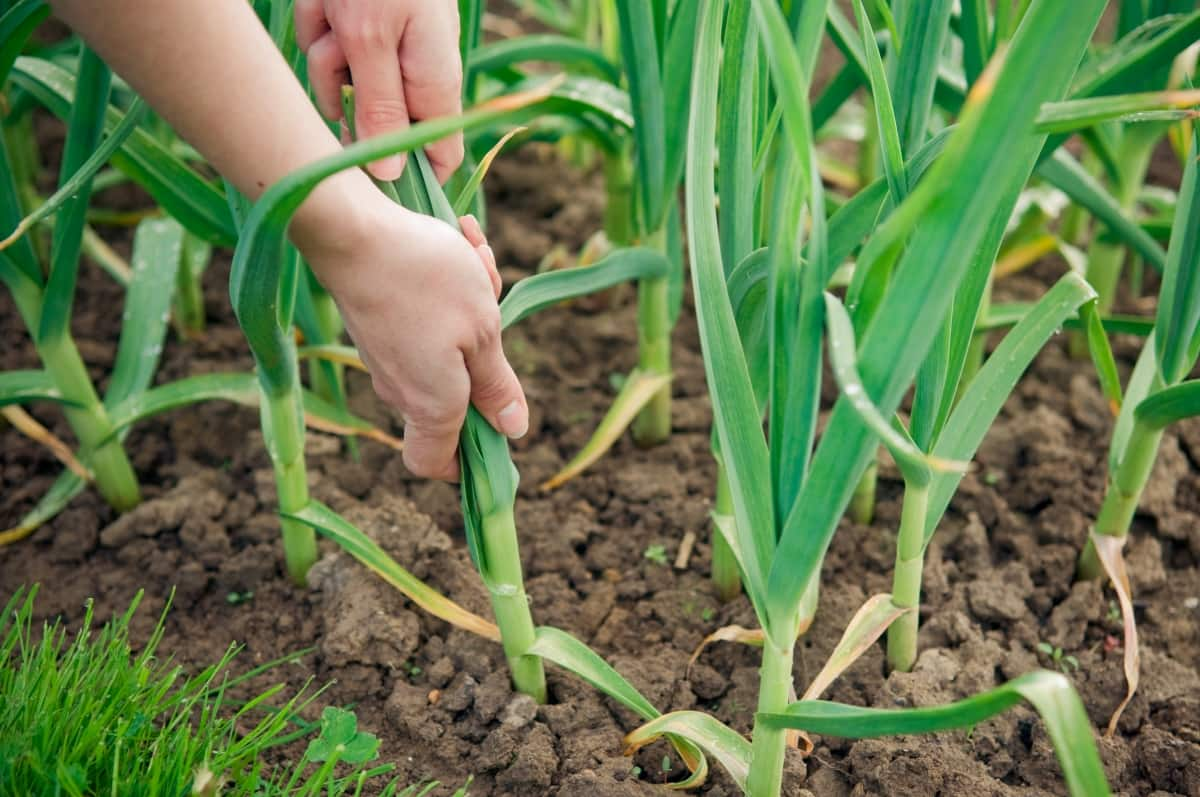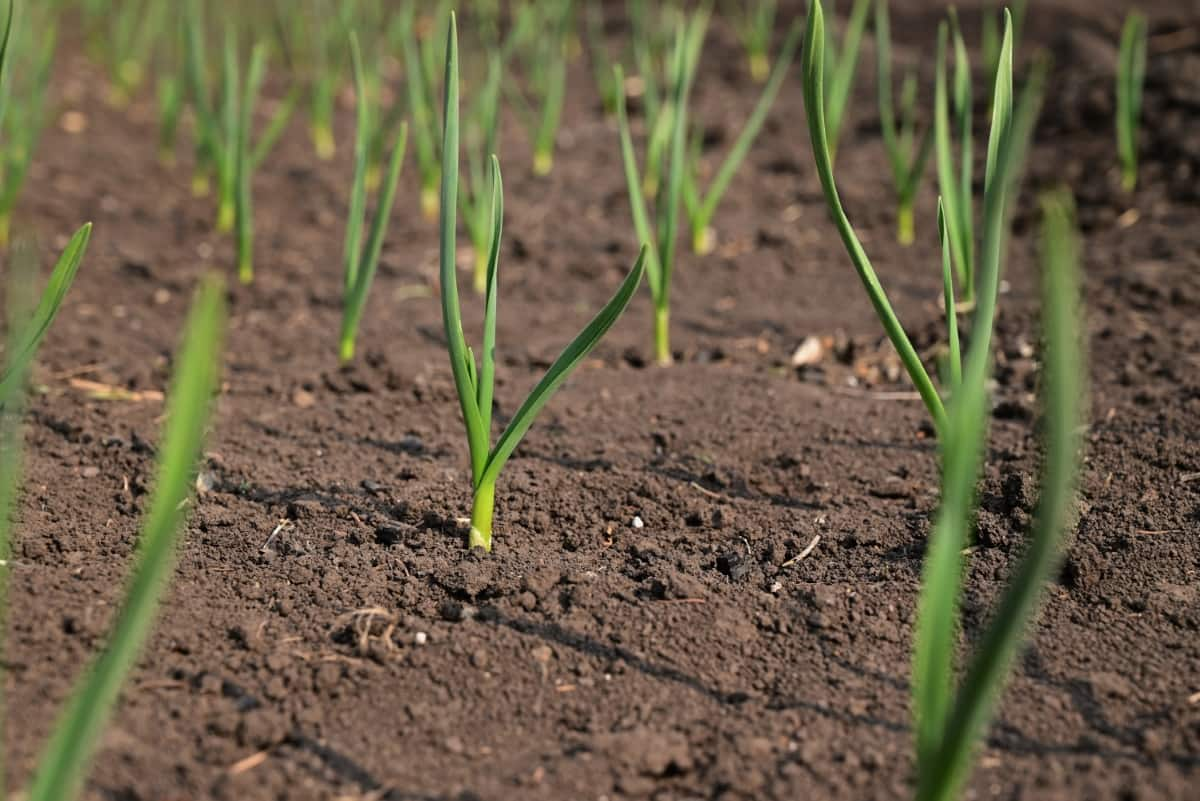Garlic plants are popular herbs used for culinary purposes but can be prone to various diseases and pests. Unfortunately, once a garlic plant has died, there is no way to bring it back to life. Knowing the causes of dying garlic plants and how to fix them can help gardeners prevent the death of these plants in the future.

9 Causes of Dying Garlic Plants
Why is My Garlic Plant Dying in Summer Heat, and How Can I Save It?
Garlic plants are sensitive to heat and need cooler temperatures to thrive. When exposed to hot summer temperatures, the plant can become stressed and unable to take up enough water and nutrients to survive. Excessive heat can cause the plant to wilt, eventually leading to death.
It is important to ensure garlic plants are planted in the right location with enough sunlight and shade. If planting in the summer, provide shade and water the plants more frequently. In addition, adding mulch around the plant can help to keep the soil cooler and retain moisture.
Preventing Garlic Plant Death from Fungal Infections: Effective Remedies and Prevention Tips
Garlic plants are susceptible to various fungal infections, including white rot, pink root rot, and gray mold. White rot is the most damaging of the fungi and can cause rot and death of the entire plant. Pink root rot can cause the roots to rot and the plant to become stunted. Gray mold can cause the leaves to become covered in a gray mold.
To prevent these fungal infections, several fungicides are available. Fungicides such as chlorothalonil, mancozeb, and copper hydroxide can prevent and control white rot, while fungicides such as iprodione and thiophanate-methyl are effective against pink root rot and gray mold.
Identifying Nutrient Deficiencies in Garlic Plants and Remedies to Revive Them
Nutrient deficiencies can cause several problems for garlic plants. Identifying and correcting them is essential for the health of your plants. The most common nutrient deficiencies in garlic plants are nitrogen, phosphorus, potassium, and magnesium. The common symptoms of nutrient deficiencies in garlic plants include yellowing of leaves, stunted growth, and wilting.
- Phosphorus Deficiency: Add bone meal or rock phosphate to the soil or use a phosphorus-rich fertilizer to fix this.
- Nitrogen Deficiency: To fix this, apply a nitrogen-rich fertilizer around the plants or use compost or manure to add more nitrogen.
- Magnesium Deficiency: To fix this, apply a magnesium-rich fertilizer to the soil or use Epsom salts.
- Potassium Deficiency: To fix this, use a potassium-rich fertilizer or compost.
How to Protect Garlic Plants from Pests and Diseases to Prevent Decline and Death
Pests can have a devastating effect on garlic plants. Common pests include aphids, spider mites, and onion thrips. These pests feed on the sap of garlic plants, sucking out nutrients and weakening the plant. Aphids also secrete a sticky substance that can encourage sooty mold growth.
- Neem oil is an organic insecticide that can protect garlic plants from pests.
- Using insecticidal soaps and diatomaceous earth can help reduce pest populations.
- Watch for pests like aphids, flea beetles, and onion maggots. Natural predators like ladybugs, lacewings, and parasitic wasps keep populations of these pests in check.
If you’re growing garlic in your garden, you’ll want to take steps to protect your plants from disease. Here are some tips on protecting your garlic plants from disease
- copper sprays on garlic plants as a preventative measure against disease. Copper is a natural fungicide that can help treat and prevent diseases such as downy mildew and scab.
- Rotate crops. Plant garlic in a different spot yearly to prevent the buildup of disease organisms in the soil.
Overwatering Issues in Garlic Plants: Signs, Symptoms, and Steps to Rescue a Dying Plant
Garlic prefers consistently moist soil. For the plant to maintain hydration, it needs moist soil that is not soggy or waterlogged. If you overwater your plants, you will accumulate lots of water around the roots, suffocating them and preventing them from sending moisture and nutrients to other parts of the plant. Initially, the leaves will become prematurely yellow, and then the plant will die.
In case you missed it: 9 Causes of Dying Cinnamon Trees and How to Fix Them?

Consider checking the soil when you notice signs of premature yellowing or drooping. Soil should be allowed to dry for a few more hours if wet. Clayey soil can sometimes cause this problem. Raised beds are an option. Due to its non-accumulative nature, it prevents overwatering. Garlic should be watered every 10-15 days if rain is expected in your area.
Underwatering Issues in Garlic Plants: Signs, Symptoms, and Steps to Rescue a Dying Plant
Garlic thrives in consistently moist soil. While the soil should be well-drained, it should also be able to retain some water. Usually, it happens during the summer when the weather is too scorching, and you don’t water properly. Premature yellowing is caused by dehydration. The leaves of the plant will wilt over time, and the plant will die as a result. Underwatering is also caused by poor retentive soil. Below steps will help you save a dying plant
- Your soil should also be able to retain moisture, such as drainage. Check the soil’s retention qualities when selecting or making well-drained soil.
- The retention qualities of the soil can be improved by adding compost and manure.
- Water the plant every three to five days. The frequency should be increased when the weather is hot and there has been no rain.
Garlic Plant Winter Damage/dying: Protecting Plants from Frost and Cold Temperatures
Garlic plants can suffer from winter damage or die if exposed to cold temperatures for too long, especially if the temperature drops below 7°C. Late-season frosts, ice storms, or extended periods of cold weather can cause this. Winter damage can manifest as yellowing, wilting, or death of the foliage. It can also cause the bulbs to rot or split and become discolored. If the soil is too wet or dry during the winter, it can also lead to winter damage or death of the garlic plants.
Covering and mulching have many benefits. By covering the garlic cloves with mulch, the harsh frost cannot reach the tender roots and kill them. The soil is also prevented from getting displaced and tearing the roots. You can cover cloves with agro fiber, plant stems, sawdust, and mulch with dry leaves, pine needles, and grass clippings.
Improper Pruning May Cause Garlic Plant Death: Pruning Methods for Healthy Growth
Garlic is an important vegetable crop; proper pruning is necessary to maintain healthy plants and maximize yields. Improper pruning of garlic plants can lead to numerous problems, including reduced yields, disease, and pest infestations.
- Pruning should be done when the leaves are still green and tender, as this is the best time for pruning. If the leaves have already begun to brown and turn yellow, they are too old to be pruned. If the leaves are pruned too early, the plant can’t be able to recover from the pruning, and the yields will be reduced.
- Over-pruning can lead to decreased yields and disease and pest infestations. The best way to avoid this is to prune only as needed and leave some stems and branches intact to support the plant.
Reviving a Stressed Garlic Plant: Rehabilitation Methods for Overall Recovery
If you have a garlic plant that has become stressed, there are several steps you can take to revive it and get it back to a healthy state. Here are some rehabilitation methods for the overall recovery of a garlic plant:
- Water Properly: Garlic plants require regular watering. It is important to water the plant deeply, as this will help it to absorb more water and nutrients.
- Prune the Plant: It helps to encourage new growth. Removing dead, diseased, or damaged leaves is important, as these can attract pests and cause more damage.
- Add Mulch and Fertilizer: Adding a layer of mulch to the soil helps to retain moisture and provide additional nutrients for the plant. Adding fertilizer can help to replenish the soil with essential nutrients and help the plant to recover more quickly.
In case you missed it: 9 Causes of Dying Cashew Trees and How to Fix Them?

Conclusion
In summary, there are several causes of dying garlic plants, including soil-borne diseases, poor drainage, pests, and environmental factors. By knowing these causes and taking steps to fix them, gardeners can ensure that their garlic plants thrive and produce a bountiful harvest.
- Feed Your Flock for Less: Top 10 Tips to Save on Chicken Feed
- Ultimate Guide to Ossabaw Island Hog: Breeding, Raising, Diet, and Care
- Hatching Answers: The Top 10 Reasons Your Chickens Aren’t Laying Eggs
- Eggs and Economics: Breaking Down the Cost of Raising Backyard Chickens
- Defend Your Greens: Proven Methods to Keep Iguanas Out of Your Garden
- Ultimate Guide to Cinnamon Queen Chicken: A Comprehensive Guide for Beginners
- Ultimate Guide to California Tan Chicken: Breeding, Raising, Diet, Egg-Production and Care
- Ultimate Guide to Marsh Daisy Chicken: Breeding, Raising, Diet, and Care
- 10 Types of Chicken Farming Businesses You Can Start for Profits